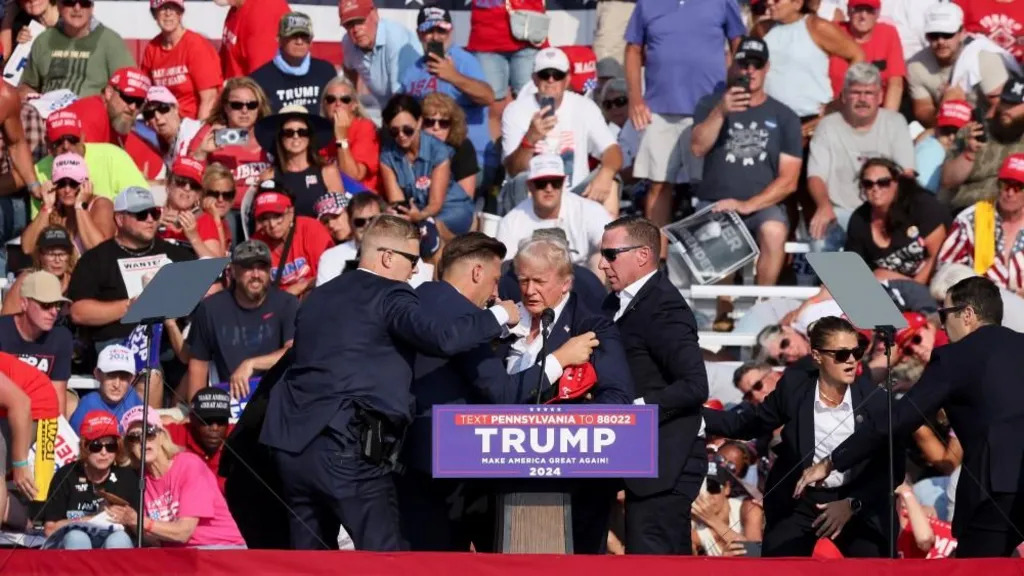No products in the cart.
Uncategorized
The 2024 Trump Rally Shooting: A Turning Point in Political Discourse
In a shocking turn of events, the recent assassination attempt on former President Donald Trump during a rally has not only shaken the political landscape but has also ignited a firestorm of conspiracy theories and hate speech across social media platforms. The aftermath of the incident has highlighted the power and pervasiveness of misinformation in the digital age, marking a significant moment in how we perceive and react to such events.
The Incident
The shooting took place at a highly anticipated rally in Dallas, Texas, where thousands of Trump supporters had gathered. As Trump addressed the crowd, shots rang out, causing chaos and panic. The gunman, later identified as 20-year-old Thomas Matthew Crooks, was quickly neutralized by the Secret Service. Despite the swift response, the attack left a mark on Trump, both physically and symbolically, as images of him with blood on his face circulated widely.
Conspiracy Theories Take Center Stage
Almost immediately after the news broke, social media platforms, especially X (formerly known as Twitter), were flooded with posts speculating that the attack was “staged.” This term quickly trended, reflecting the deep-seated mistrust and propensity for conspiracy theories that have become a hallmark of contemporary social media culture.
Many of these theories began with seemingly legitimate questions about security lapses. Users questioned how the attacker managed to reach the roof of the building undetected and why there wasn’t a more robust security presence. These queries soon morphed into elaborate conspiracy theories, with users suggesting that the entire event was orchestrated to garner sympathy for Trump or to distract from other political issues.
One particularly viral post claimed, “It looks very staged. Nobody in the crowd is running or panicking. Nobody in the crowd heard an actual gun. I don’t trust it. I don’t trust him.” Despite these claims being debunked by subsequent footage and testimonies, the initial post racked up millions of views, illustrating how quickly misinformation can spread.
The Role of Social Media
The reaction on X was unprecedented in its scale and intensity. Unlike previous assassination attempts, this one unfolded in real-time, with live updates and user-generated content driving the narrative. The platform’s algorithm, which prioritizes engagement, played a significant role in amplifying these conspiracy theories. Posts from users with blue ticks, who had purchased verification, were given greater prominence, further fueling the spread of misinformation.
A widely circulated photograph taken by Associated Press photographer Evan Vucci became a focal point for conspiracy theorists. The image showed Trump, fist raised, with blood on his face and the American flag in the background. Critics argued that the picture was “too perfect,” suggesting it was staged. Despite the photographer’s and eyewitnesses’ accounts confirming its authenticity, the image continued to be a lightning rod for speculation.
Political Reactions and Misuse of Information
The assassination attempt and the ensuing conspiracy theories have had a polarizing effect on the political discourse. Elected officials, including Congressman Mike Collins, have made inflammatory statements, further dividing public opinion. Collins accused President Joe Biden of orchestrating the attack, citing a comment Biden made earlier in the week about putting “Trump in a bullseye.” Although Collins’ post garnered over 6 million views, it was later flagged for misinformation, with community notes clarifying that Biden’s remark was taken out of context and there was no evidence linking him to the attack.
Such statements reflect a broader trend where political figures and influencers exploit misinformation to rally their base. This tactic not only undermines public trust but also escalates tensions, making it increasingly difficult to distinguish between fact and fiction.
The Real Impact of the Shooting
Beyond the conspiracy theories, the real impact of the shooting lies in its potential to reshape the 2024 presidential race. The attempt on Trump’s life has already galvanized his supporters, who see him as a martyr fighting against a corrupt establishment. Conversely, it has also intensified the resolve of his detractors, who view the incident as a dangerous escalation in a highly charged political climate.
The incident has also raised serious questions about security protocols at political events. How did Crooks, a relatively unknown individual, manage to bypass multiple layers of security? What measures can be implemented to prevent such incidents in the future? These are crucial questions that need addressing to ensure the safety of public figures and the integrity of democratic processes.
The Spread of False Narratives
The spread of false narratives did not stop at the shooting itself. Before the FBI confirmed the identity of the shooter, other individuals were falsely accused. Notably, Marco Violi, a football commentator from Italy, was wrongfully identified as the attacker. Violi took to Instagram to clear his name, but by then, the damage had been done. The false accusations had millions of views, demonstrating the destructive power of misinformation.
The Test for Social Media Platforms
This incident has been a litmus test for social media platforms, particularly X, which has struggled to manage the deluge of conspiracy theories and hate speech. Under Elon Musk’s ownership, the platform’s policies and algorithms have come under scrutiny. While community notes and fact-checking efforts have been implemented, they often lag behind the rapid spread of misinformation. Other social media sites, possibly due to their different user demographics and stricter content moderation policies, did not experience the same level of inundation, highlighting the unique challenges X faces as a hub for political discourse.
A Call for Responsible Social Media Use
In the wake of the Trump rally shooting, there is an urgent need for responsible social media use. Users must critically evaluate the information they encounter and share, especially in the immediate aftermath of such incidents. Social media platforms, on their part, must enhance their content moderation practices and algorithmic transparency to curb the spread of misinformation.
Conclusion: Navigating a Complex Landscape
The 2024 Trump rally shooting has underscored the complexities of our modern information landscape. It has shown how quickly misinformation can spread and the profound impact it can have on public discourse. As we move forward, it is imperative to foster a culture of critical thinking and accountability, both online and offline.
For those interested in commemorating this significant moment in political history, the Viraldes Store offers the Trump Shot 2024 Air Force 1 Sneakers. These unique sneakers not only serve as a reminder of the event but also symbolize the ongoing struggle for truth and transparency in our digital age.

Explore our entire Trump collection for more memorabilia and show your support. Visit Viraldes Store today for a wide range of products that capture the spirit of this pivotal moment in American politics.


